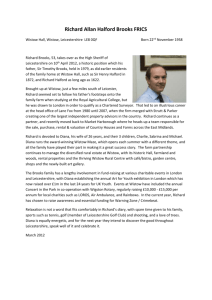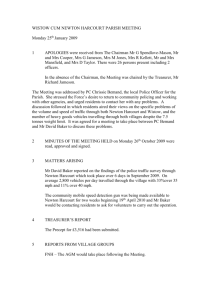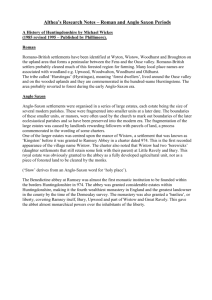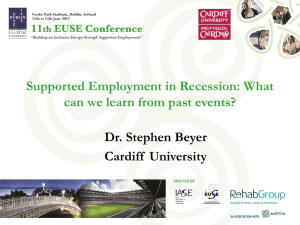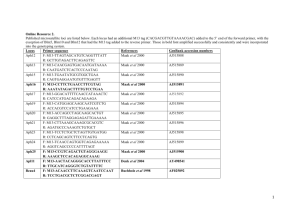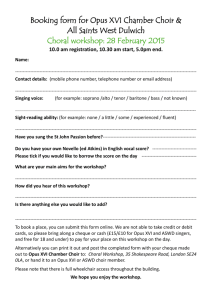Various Notes by Inskip (Author of the Victoria
advertisement
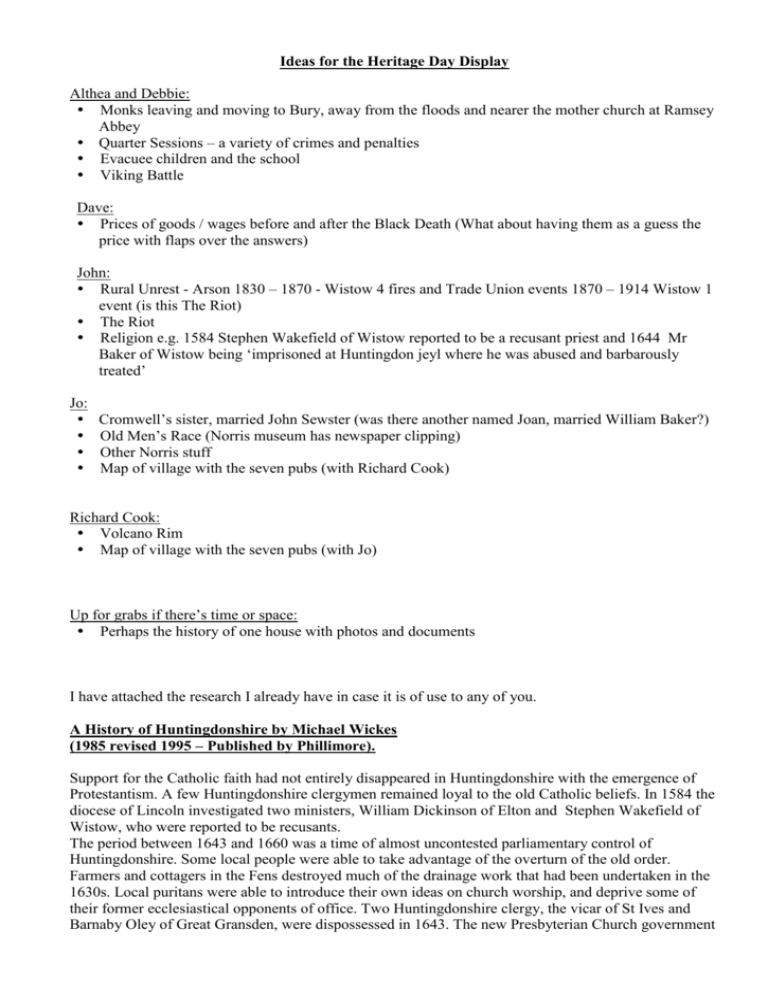
Ideas for the Heritage Day Display Althea and Debbie: Monks leaving and moving to Bury, away from the floods and nearer the mother church at Ramsey Abbey Quarter Sessions – a variety of crimes and penalties Evacuee children and the school Viking Battle Dave: Prices of goods / wages before and after the Black Death (What about having them as a guess the price with flaps over the answers) John: Rural Unrest - Arson 1830 – 1870 - Wistow 4 fires and Trade Union events 1870 – 1914 Wistow 1 event (is this The Riot) The Riot Religion e.g. 1584 Stephen Wakefield of Wistow reported to be a recusant priest and 1644 Mr Baker of Wistow being ‘imprisoned at Huntingdon jeyl where he was abused and barbarously treated’ Jo: Cromwell’s sister, married John Sewster (was there another named Joan, married William Baker?) Old Men’s Race (Norris museum has newspaper clipping) Other Norris stuff Map of village with the seven pubs (with Richard Cook) Richard Cook: Volcano Rim Map of village with the seven pubs (with Jo) Up for grabs if there’s time or space: Perhaps the history of one house with photos and documents I have attached the research I already have in case it is of use to any of you. A History of Huntingdonshire by Michael Wickes (1985 revised 1995 – Published by Phillimore). Support for the Catholic faith had not entirely disappeared in Huntingdonshire with the emergence of Protestantism. A few Huntingdonshire clergymen remained loyal to the old Catholic beliefs. In 1584 the diocese of Lincoln investigated two ministers, William Dickinson of Elton and Stephen Wakefield of Wistow, who were reported to be recusants. The period between 1643 and 1660 was a time of almost uncontested parliamentary control of Huntingdonshire. Some local people were able to take advantage of the overturn of the old order. Farmers and cottagers in the Fens destroyed much of the drainage work that had been undertaken in the 1630s. Local puritans were able to introduce their own ideas on church worship, and deprive some of their former ecclesiastical opponents of office. Two Huntingdonshire clergy, the vicar of St Ives and Barnaby Oley of Great Gransden, were dispossessed in 1643. The new Presbyterian Church government introduced an even more exacting ordinance in 1644, which evicted about twenty clergymen. Some of whom were treated quite harshly, Mr Baker of Wistow being ‘imprisoned at Huntingdon jeyl where he was abused and barbarously treated’. The Victoria History of the County of Huntingdonshire Volume II Edited by William Page, Granville Proby & S. Inskip Ladds 1932 reprinted 1974 Anna Cromwell, younger sister to Oliver Cromwell, The Lord Protector, was born 2nd Jan 1602/3 and baptised 16th January following. She married John Sewster and was buried at Wistow on 1st Nov 1646. Wistow Yearly wages before 1350: Ploughman 3s 1297 & 1394 (5s Somersham 1327-28, 2s Elton 1311-12) Carter 3s 1297 & 1394 Shepherd 3s 1324 Cowherd 3s 1324 Swineherd 2s 3d 1297 Woodward 4s 1324 Dairyman 3s 1297 Thatching 2d per day 1325 Wistow Yearly Wages after 1350: Ploughman (7s fixed minimum wage 1389) Carter (10s 6d fixed minimum wage 1389) Shepherd (10s 6d fixed minimum wage 1389) Cowherd (6s 8d fixed minimum wage 1389) Cook 6s Wistow 1368 6s Wistow 1368 (also others e.g. Abbots Ripton) 6s Wistow 1363 –4, 1374-5 also others 6s Wistow (“) 6s Wistow (“) Agricultural wages for county in 1793: 12d –14d a day from end of harvest to haytime 18d a day from hay time to harvest 2s 6d a day during harvest, with beer If by the month, c. 42s for the whole harvest with beer and board Mowing Hay, Barley and Beans – 2s an acre Threshing Wheat - 2s a quarter Threshing Barley and Beans – 14d to 20d a quarter Reaping – 7s to 9s an acre Ditching – per 22yards - 2 ½ ft wide 1s; 3ft wide 1s 6d; 4 ft wide 2s Digging 3d per square yard Women weeding 6d per day Women Haymaking 1s per day Women harvest 1s per day Agricultural wages for the county in 1813: Average 11s 3d a week in winter, 13s 8d in summer, exclusive of meat and drink given in some places, and of harvest month, where there is much local variation. A day is reckoned from light to dark in winter and harvest time, from 6a.m. to 6p.m. in spring and summer. Reaping Oats in the Fens – 10s to 12s an acre Reaping Coleseed (what is this?) – 8s an acre Mowing Hay – 3s an acre Weeding Oats in the Fens – 8s to 10s an acre Stocking and Raking Barley and Beans – 1s 7d to 1s 10d and 2s 7d. Puddling – 3s per pole Underdraining – 3s for 22yards Threshing Wheat – 2s a load of 5 bushels Threshing Barley – 2s 6d per quarter Threshing Beans etc. – 1s 4d to 1s 8d per quarter Threshing Coleseed – 90s per last. Prices before 1350: Horse 20s Wistow 1316 Calf 8d Wistow 1297 Ox 24s Wistow 1324 Cow 6s 8d Wistow 1297 Pigs 5s 8d Wistow 1316 and 4s 6d Wistow 1324-5; Prices after 1350: Pig 2s 1d Wistow 1351 Geese 3d Wistow 1351 Prices for the county in 1770: Beef 3¾d or 4d a lb Mutton 3½d or 4d a lb Pork 4d a lb Bread 1¾d a lb Butter 6d or 7d a lb Veal 3½d or 4d a lb Cheese 4d a lb Prices for the county in 1813: Beef and Mutton – Huntingdon 8s a stone; St Neots 8d a lb Lamb – Huntingdon 11s 8d a stone; St Neots 10d a lb Pork – Huntingdon 9s a stone; St Neots 9d a lb Veal – Huntingdon 10s 6d a stone Wheat for Bread – St Neots 10s a bushel Bread – St Neots 11d a quartern Cheese 7d a lb Butter 1s 2d a lb Eggs 10d a score Milk 1d a pint Peas 6d a peck Beans 4d a peck Cabbage 1d Fowls 4s 6d for 2 Ducks 3s for 2 Geese 5s each Turkeys 7s each Coal 14d, 15d, 16d, 18d, 20d a bushel Turf 12s – 16s a thousand Coal it was noted was burnt principally in the better kind of houses Tenants in Wistow: 1336 Virgaters. –Ad opus 23; ad censum 5½; in officiis 3. Total 31½. Cotmen.- Ad opus 9. Hidemen 5. 1351 Virgaters. – Ad opus 21 ½; ad censum 3; in officiis 3; nihil porter impotent’ 4. Total 31 ½. Cotmen. – Ad opus 2; ad censum 3; impotens 7. Total 12. Hidemen. – 3; in manu domini 2.Total 5 1368 Virgaters. – Ad opus 19; ad censum 7¼; in officiis 3½; arentati 2¾. Total 32½. Cotmen. – Ad opus 1; ad censum 9; arentati ½; in manu domini 1. total 11 ½. Hidemen. – ad opus 5. In Wistow 30 acres equalled one virgate, 4 virgates equalled one hide; 13th century: At Wistow carrying a cartload to Ramsey was reckoned as two works i.e. the villein was released from two weeks work with the exception of ploughing. At Wistow in 1324 - 80 men with 20 ploughs received fish worth 3s 2d, 2 rings of corn and 3 rings of malt; in 1351 – 102 men received 2 cows, 6 rings of corn, 2 rings of malt, 8lbs cheese and 2 geese. Generally a day’s work was sunrise to sunset but at Wistow harvesting from dawn to noon was regarded as one work. At harvest time the villein arrived with his whole household except his wife but including his children. An Atlas of Cambridgeshire and Huntingdonshire History edited by Tony Kirby and Susan Oosthuizen (Published 2000 by Anglia Polytechnic University) the Danelaw shires were more prosperous than their English counterparts in Wessex and Mercia. This difference in prosperity may be one of the motivating factors for a series of campaigns mounted in 917 by King Edward the Elder and his sister Aethelflaed, Lady of the Mercians (children of Alfred the Great), for recovery of parts of the Danelaw south of Welland. After defeating the Danish Army under Earl Toglos decisively at Huntingdon and Wistow, Edward accepted the surrender of the Danes of Cambridgeshire and the 37 year autonomy of the two shires came to an abrupt end. Rural Unrest Arson 1830 – 1870 Trade Union events 1870 – 1914 Wistow 4 fires Wistow 1 event Hearth tax Michaelmas 1664 The Hearth tax shows that Wistow had between 51 and 100 hearths i.e. households whereas Upwood and Bury had between 26 and 50, so the relative size of villages can be surmised. It is rash to use these figures to calculate population, as some households were exempt and not shown in the lists. Also there were some single person households, often widows who were excused payment. The tax was levied as 2s per hearth. ………………………………………………………………………………………………………. These are the notes I made after visiting the Norris Museum: Norris Museum – St Ives Curator – Bob Burn-Murdock Artefacts No artefacts from Wistow. Suggests contacting the Sites and Monuments Records. Artefacts may not still exist, but they will have been recorded. Photos Photo of Enclosure map – very small and difficult to read all the detail even with magnifying glass. The larger original will be held by Cambridge University Library – ask at Records Office. Various Notes by Inskip (Author of the Victoria History Series) e.g. Notes and sketches of the church Ramsey Charter Papal Bull of Gregory IX confirming Chapels of Upwood, Ravely and Wistow 4/12/1228 Papal Bull of Gregory IX 21/06/1229 confirms Villas de Riptone, The Ravele, De Wistowe, de Upwoode (Latin required to understand the charter and bulls) Notes re. Manor from 1600s (John Sewster, husband of Anna Cromwell etc) Some genealogy and family trees Correspondence from Ministry of Transport re widening of Wistow Bridge 18/10/1937 List of the patrons of the vicars of Wistow church Re. Registers from the church. Oldest register begins for baptisms and burials 1628 and for marriages from 1630. Continuous to 1705. Next begins 1715 and is continuous, but there are loose leaves for 1705 to 1714. (Are these registers are held at the Records Office now and not in the church?) Newspaper cuttings from Hunts Post 11/01/1902 and later: 1. American Disaster 10/06/1926 when the eldest son of the vicar of Wistow drowned along with his wife and young son. Mr and Mrs William Noble and 7 year old William Thomas Noble. Died May 31st buried June 2nd. Car plunged into river. 2. Article with the wonderful title “Wistow and its People. A Typical Huntingdonshire Parish. The Old Time Notes of a Native.” 15/07/1911 3. Wistow Mill 4. Adverts of arms for sale Newspaper Cuttings First piece written after 1803 Then cuttings dated more definitely from 1827 to 1927 Lots of cuttings on the church and funerals The American Drowning Incident African Missionary OAP Marathon Race 04/07/1911 (my personal favourite). Race won by William Burton aged 82 years, Race followed by drinks at the Fleur de Lys – a couple of great photos Notes of a Native 18/08/1911 (as in Inskips notes) Wistow Feast 07/07/1927 ………………………………………………………………………………………………………….. Email from Cromwell Museum curator: I would recommend you look at The Cromwellian Gazeteer by Peter Gaunt which is available from the Museum or the library. It states the following, Wistow - The Tudor Manor House was bought by the Cromwells in the sixteenth century and although Oliver's uncle, Sir Oliver, sold the place in 1649, the family retained a connection with Wistow until the end of the century. Oliver's sister Anna lived at Wistow with her husband John Sewster, and several of their children remained in the village throughout their lives. In unmarked graves in or around St John's Church lie John(d1680/1) and Anna (d1646) and five of their six children (d between 1642 and 1705). Mike Brooks
